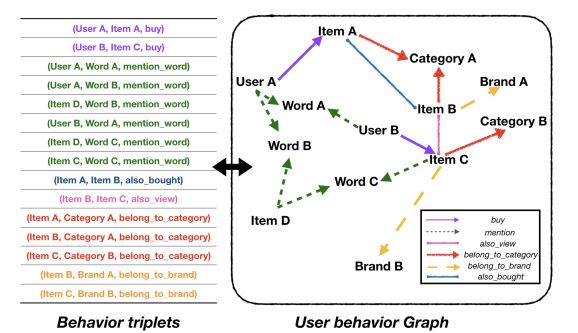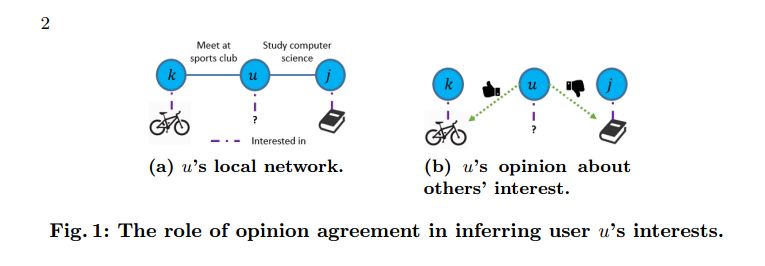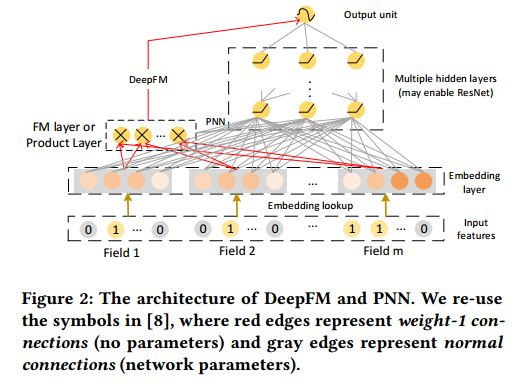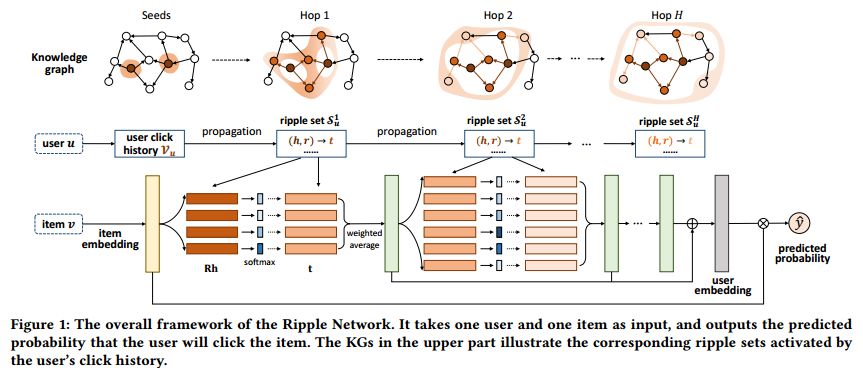【论文推荐】最新七篇推荐系统相关论文—影响兴趣、知识Embeddings、 音乐推荐、非结构化、一致性、显式和隐式特征、知识图谱
【导读】专知内容组整理了最近七篇推荐系统(Recommender System)相关文章,为大家进行介绍,欢迎查看!
1.Learning Recommendations While Influencing Interests(在影响兴趣的同时学习推荐)
作者:Rahul Meshram,D. Manjunath,Nikhil Karamchandani
摘要:Personalized recommendation systems (RS) are extensively used in many services. Many of these are based on learning algorithms where the RS uses the recommendation history and the user response to learn an optimal strategy. Further, these algorithms are based on the assumption that the user interests are rigid. Specifically, they do not account for the effect of learning strategy on the evolution of the user interests. In this paper we develop influence models for a learning algorithm that is used to optimally recommend websites to web users. We adapt the model of \cite{Ioannidis10} to include an item-dependent reward to the RS from the suggestions that are accepted by the user. For this we first develop a static optimisation scheme when all the parameters are known. Next we develop a stochastic approximation based learning scheme for the RS to learn the optimal strategy when the user profiles are not known. Finally, we describe several user-influence models for the learning algorithm and analyze their effect on the steady user interests and on the steady state optimal strategy as compared to that when the users are not influenced.
期刊:arXiv, 2018年3月23日
网址:
http://www.zhuanzhi.ai/document/513db2a850d4db1d1ce478b1ffd40353
2.Learning over Knowledge-Base Embeddings for Recommendation(在基于知识embeddings的基础上学习推荐)
作者:Yongfeng Zhang,Qingyao Ai,Xu Chen,Pengfei Wang
机构:Tsinghua University,Beijing University of Posts and Telecommunications
摘要:State-of-the-art recommendation algorithms -- especially the collaborative filtering (CF) based approaches with shallow or deep models -- usually work with various unstructured information sources for recommendation, such as textual reviews, visual images, and various implicit or explicit feedbacks. Though structured knowledge bases were considered in content-based approaches, they have been largely neglected recently due to the availability of vast amount of data, and the learning power of many complex models. However, structured knowledge bases exhibit unique advantages in personalized recommendation systems. When the explicit knowledge about users and items is considered for recommendation, the system could provide highly customized recommendations based on users' historical behaviors. A great challenge for using knowledge bases for recommendation is how to integrated large-scale structured and unstructured data, while taking advantage of collaborative filtering for highly accurate performance. Recent achievements on knowledge base embedding sheds light on this problem, which makes it possible to learn user and item representations while preserving the structure of their relationship with external knowledge. In this work, we propose to reason over knowledge base embeddings for personalized recommendation. Specifically, we propose a knowledge base representation learning approach to embed heterogeneous entities for recommendation. Experimental results on real-world dataset verified the superior performance of our approach compared with state-of-the-art baselines.
期刊:arXiv, 2018年3月23日
网址:
http://www.zhuanzhi.ai/document/4a7f93d4541c08412376c92c7ac72f98
3.Current Challenges and Visions in Music Recommender Systems Research(音乐推荐系统研究中的当前挑战与展望)
作者:Markus Schedl,Hamed Zamani,Ching-Wei Chen,Yashar Deldjoo,Mehdi Elahi
机构:Johannes Kepler University,University of Massachuses
摘要:Music recommender systems (MRS) have experienced a boom in recent years, thanks to the emergence and success of online streaming services, which nowadays make available almost all music in the world at the user's fingertip. While today's MRS considerably help users to find interesting music in these huge catalogs, MRS research is still facing substantial challenges. In particular when it comes to build, incorporate, and evaluate recommendation strategies that integrate information beyond simple user--item interactions or content-based descriptors, but dig deep into the very essence of listener needs, preferences, and intentions, MRS research becomes a big endeavor and related publications quite sparse. The purpose of this trends and survey article is twofold. We first identify and shed light on what we believe are the most pressing challenges MRS research is facing, from both academic and industry perspectives. We review the state of the art towards solving these challenges and discuss its limitations. Second, we detail possible future directions and visions we contemplate for the further evolution of the field. The article should therefore serve two purposes: giving the interested reader an overview of current challenges in MRS research and providing guidance for young researchers by identifying interesting, yet under-researched, directions in the field.
期刊:arXiv, 2018年3月22日
网址:
http://www.zhuanzhi.ai/document/040f1775628bf7d35d98d8b04c817161
4.Product Characterisation towards Personalisation: Learning Attributes from Unstructured Data to Recommend Fashion Products(个性化的产品特性:从非结构化数据中学习属性来推荐时尚产品)
作者:Ângelo Cardoso,Fabio Daolio,Saúl Vargas
机构:Universidade de Lisboa
摘要:In this paper, we describe a solution to tackle a common set of challenges in e-commerce, which arise from the fact that new products are continually being added to the catalogue. The challenges involve properly personalising the customer experience, forecasting demand and planning the product range. We argue that the foundational piece to solve all of these problems is having consistent and detailed information about each product, information that is rarely available or consistent given the multitude of suppliers and types of products. We describe in detail the architecture and methodology implemented at ASOS, one of the world's largest fashion e-commerce retailers, to tackle this problem. We then show how this quantitative understanding of the products can be leveraged to improve recommendations in a hybrid recommender system approach.
期刊:arXiv, 2018年3月21日
网址:
http://www.zhuanzhi.ai/document/e187e84da06667f00a4cefcde5667d32
5.Similar but Different: Exploiting Users' Congruity for Recommendation Systems(类似但不同:利用用户对推荐系统的一致性)
作者:Ghazaleh Beigi,Huan Liu
机构:Arizona State University
摘要:The pervasive use of social media provides massive data about individuals' online social activities and their social relations. The building block of most existing recommendation systems is the similarity between users with social relations, i.e., friends. While friendship ensures some homophily, the similarity of a user with her friends can vary as the number of friends increases. Research from sociology suggests that friends are more similar than strangers, but friends can have different interests. Exogenous information such as comments and ratings may help discern different degrees of agreement (i.e., congruity) among similar users. In this paper, we investigate if users' congruity can be incorporated into recommendation systems to improve it's performance. Experimental results demonstrate the effectiveness of embedding congruity related information into recommendation systems.
期刊:arXiv, 2018年3月16日
网址:
http://www.zhuanzhi.ai/document/c79c87c517160b413d44dd40805ba0c9
6.xDeepFM: Combining Explicit and Implicit Feature Interactions for Recommender Systems(xDeepFM: 结合显式和隐式特征交互的推荐系统)
作者:Jianxun Lian,Xiaohuan Zhou,Fuzheng Zhang,Zhongxia Chen,Xing Xie,Guangzhong Sun
机构:University of Science and Technology,Beijing University of Posts and Telecommunications
摘要:Combinatorial features are essential for the success of many commercial models. Manually crafting these features usually comes with high cost due to the variety, volume and velocity of raw data in web-scale systems. Factorization based models, which measure interactions in terms of vector product, can learn patterns of combinatorial features automatically and generalize to unseen features as well. With the great success of deep neural works (DNNs) in various fields, recently researchers have proposed several DNN-based factorization model to learn both low- and high-order feature interactions. Despite the powerful ability of learning an arbitrary function from data, plain DNNs generate feature interactions implicitly and at the bit-wise level. In this paper, we propose a novel Compressed Interaction Network (CIN), which aims to generate feature interactions in an explicit fashion and at the vector-wise level. We show that the CIN share some functionalities with convolutional neural networks (CNNs) and recurrent neural networks (RNNs). We further combine a CIN and a classical DNN into one unified model, and named this new model eXtreme Deep Factorization Machine (xDeepFM). On one hand, the xDeepFM is able to learn certain bounded-degree feature interactions explicitly; on the other hand, it can learn arbitrary low- and high-order feature interactions implicitly. We conduct comprehensive experiments on three real-world datasets. Our results demonstrate that xDeepFM outperforms state-of-the-art models. We have released the source code of xDeepFM at https://github.com/Leavingseason/xDeepFM.
期刊:arXiv, 2018年3月15日
网址:
http://www.zhuanzhi.ai/document/771b19587b0b9da76ce1e836d06e59b6
7.Ripple Network: Propagating User Preferences on the Knowledge Graph for Recommender Systems(波纹网络:在推荐系统的知识图上传播用户偏好)
作者:Hongwei Wang,Fuzheng Zhang,Jialin Wang,Miao Zhao,Wenjie Li,Xing Xie,Minyi Guo
机构:Shanghai Jiao Tong University,The Hong Kong Polytechnic University
摘要:To address the sparsity and cold start problem of collaborative filtering, researchers usually make use of side information, such as social networks or item attributes, to improve recommendation performance. This paper considers the knowledge graph as the source of side information. To address the limitations of existing embedding-based and path-based methods for knowledge-graph-aware recommendation, we propose Ripple Network, an end-to-end framework that naturally incorporates the knowledge graph into recommender systems. Similar to actual ripples propagating on the surface of water, Ripple Network stimulates the propagation of user preferences over the set of knowledge entities by automatically and iteratively extending a user's potential interests along links in the knowledge graph. The multiple "ripples" activated by a user's historically clicked items are thus superposed to form the preference distribution of the user with respect to a candidate item, which could be used for predicting the final clicking probability. Through extensive experiments on real-world datasets, we demonstrate that Ripple Network achieves substantial gains in a variety of scenarios, including movie, book and news recommendation, over several state-of-the-art baselines.
期刊:arXiv, 2018年3月9日
网址:
http://www.zhuanzhi.ai/document/ec777791a9d080123eb5e32299007615
-END-
专 · 知
人工智能领域主题知识资料查看获取:【专知荟萃】人工智能领域26个主题知识资料全集(入门/进阶/论文/综述/视频/专家等)
同时欢迎各位用户进行专知投稿,详情请点击:
【诚邀】专知诚挚邀请各位专业者加入AI创作者计划!了解使用专知!
请PC登录www.zhuanzhi.ai或者点击阅读原文,注册登录专知,获取更多AI知识资料!
请扫一扫如下二维码关注我们的公众号,获取人工智能的专业知识!
请加专知小助手微信(Rancho_Fang),加入专知主题人工智能群交流!加入专知主题群(请备注主题类型:AI、NLP、CV、 KG等)交流~
点击“阅读原文”,使用专知!













